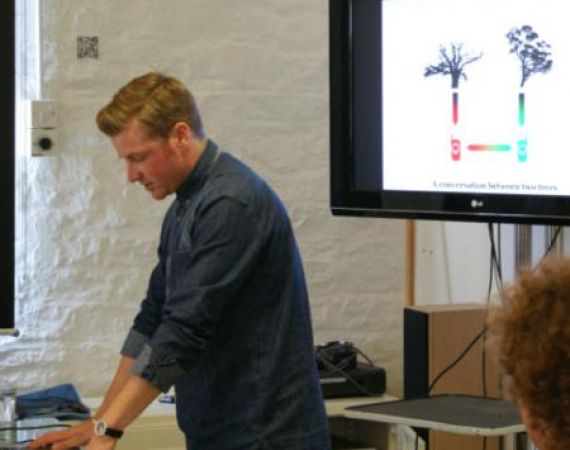Posted on Thu 20 Oct 2011
Last Week’s Lunchtime Talk: A Conversation Between Trees
The Studio's weekly Lunchtime Talks are open to anyone to attend and feature members of the Studio community and invited guests presenting their projects and inviting discussion. Attendance at the talks has been growing steadily over the last few months, so we thought it was time to start…

Matt Davenport's Lunchtime Talk
The Studio's weekly Lunchtime Talks are open to anyone to attend and feature members of the Studio community and invited guests presenting their projects and inviting discussion. Attendance at the talks has been growing steadily over the last few months, so we thought it was time to start documenting them for people who can't attend.
Matt Davenport is Head of Media Arts at Broadway, Nottingham, and since 1997 has worked as part of Active Ingredient creating playful location-based installations or games. His lunchtime talk on Friday 14th October was about A Conversation Between Trees, a project conceived and developed by Active Ingredient between residencies in the UK and Brazil.
The project started life as a research project called The Dark Forest - here is a timeline of the development of the idea:
Nov 2008 - Research field trips to Atlantic Forest, Brazil
Jan 2009 - Mobilefest visit Sherwood Forest
Apr 2009 - Research field trips to Atlantic Forest, Brazil
Nov 2009 - Mobilefest exhibition at MIS - Museu da Imagem e do Som de São Paulo
Mar - Aug 2010 - Schools Workshops
Aug 2010 - Research Residency at the Yorkshire Sculpture Park
Nov 2010 - EME Estudio Movel Experimental Research Residency
May 2011 - Jan 2012 - Exhibition Tour in UK Forest Regions
When Active Ingredient were invited to Sao Paulo by MobileFest, they were inspired to think about whether trees could have a conversation. They went out into the jungle with rangers and discovered the importance of the forest to local people, and the lawlessness of the tree-covered land, which is very difficult to govern. They noted the fight between nature and human intervention.
Their ideas for the project came from a desire to re-create the feeling of looking up at a tropical canopy, despite standing in a temperate UK forest. Drawing parallels between the two forests became the obvious way to develop the project, and comparing and visualising live data was what they aimed for. For their first installation they set up cameras looking up towards the canopy. Every minute the camera took a photo, the visualization takes the photo, pixelates it, explodes the pixels outwards and adds different colour-hues depending on the live data recorded. The result is amazing, and the fact it looks beautiful is solely down to a good concept, and luck:

After further residencies and research projects Active Ingreditent then extended the live data projections to take into account variables of humidity, C02, light, colour and sound. They decided to supplement these visualisations, depicting conversations between Brazilian and British trees, by bringing in an awareness of climate change.

They conceived a climate machine, a circular sculpture that draws the global climate C02 levels from the last 70 years by scorching rings into a stack of circular sheets of recycled paper, stacked 1m high. A soldering iron was connected to a computer and controlled by the C02 data. Each sheet of paper shows a ring created by annual global climate C02 levels. They worked backwards from April 2011 and drew as many years per day as they could throughout the 2 weeks (the data goes back to 1958).
Each sheet shows monthly, seasonal and yearly changes in C02 through the shape of each ring and shows the steady annual increase that has occurred over the last 50-70 years. The unique artworks look just like the rings of trees we use to measure age.
At the end of each rotation the sheet was taken off the machine by the invigilator, embossed with the date and hung within the gallery.

The next extension of the project was to make the exhibition interactive. An app was developed so that visitors to the installations couldwalk out into thesurrounding woods and view live visualisations, whilst pointing their phone's camera at different areas of the forest. The app relies on 3G to update the phone, but is as close to live-data as they could get. It allows you to observe how environmental factors are affecting trees around you. At random, the app also asks questions, acting as a human data collector to discover how people respond to their environment, and their findings through the app. Many responses indicated the visualisations extended the experience, some even commented it was evocative of standing beneath a more tropical canopy..

The next step Active Ingredient want to make is to connect the human data collected with the existing visualisation, to build the conversation to include those experiencing it.
The audience had a lot of questions about specific aspects of Active Ingredient's work, their residencies and workshops. The conversation closed with a definite feeling that despite problems and limitations, the project was an important, exciting thing - making climate-change data accessible and visual for the public, when it would usually be hidden away in research.
The touring exhibition is currently at the Centre for Contemporary Art and the Natural World in Devon. You can visit the installation until January 2012.